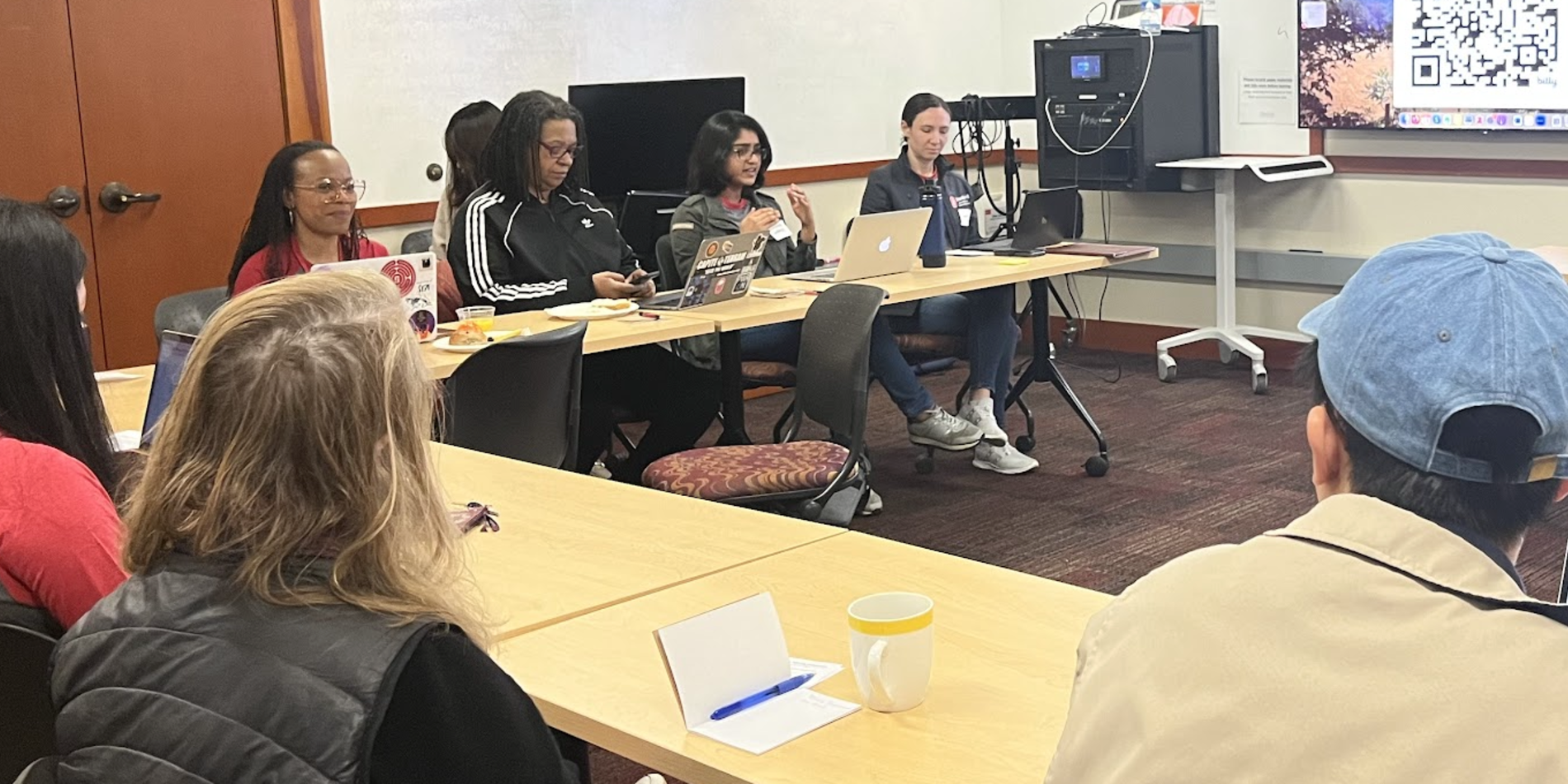Image courtesy of Sally Kim.
To observe the enzyme activity that contributes to tumor proliferation, Lydia Tam’s original research builds on new understanding of the high-grade glioma micro-environment. Lydia honed her research argument while enrolled in Biology 199W, a Writing in the Major course devoted to the writing of the honors thesis in biology. The class asks students to repeatedly test their work in progress with varied readers and listeners, developing their technical communication. Lydia’s instructor Dr. Sally Kim observed her “refreshingly well written [results section] with excellent context, transitions, narrative line, and exceptional figures” and nominated her for a Hoefer Prize in 2017, which Lydia won for her thesis “Identifying the Cellular Origin and Enzymatic Mechanism of Activity-regulated Neuroligin-3 Secretion.”
In Stanford’s Biology department, students are invited to take more than one Writing in the Major course and can choose from up to ten. For students who are planning to pursue independent research in biology, two WIM courses are particularly valuable, Biology 168: Explorations in Stem Cell Biology, taught by Dr. Jamie Imam, and Biology 199W: Senior Honors Thesis: How to Write Effectively about Scientific Research, currently team taught by Dr. Kim and Dr. Imam. The former, ideally taken by juniors, asks students to engage repeatedly and critically with the primary literature to prepare them to craft their own original research proposals. The latter emphasizes communicating science across modes and genres. Both courses capitalize on the interconnections between reading, writing, listening, and speaking as students articulate and revise their ideas. Both courses emphasize that “if you can’t communicate about science, you can’t do science” as Dr. Imam put it.
BIOLOGY 168
Reading like Scientists
During the first half of Bio 168, students read at least two scholarly articles a week: one “primary literature,” typically a breakthrough study of stem cells, the other a review essay that analyzes the research that has followed the study. Students then write two responses each week. In a one page, single-spaced reading response students think like scientific journal reviewers, considering the purpose, significance, strengths, and limitations of what would become pivotal papers (see, for example, Takahashi, K and S. Yamanaka. 2006. Induction of pluripotent stem cells from mouse embryonic and adult fibroblast cultures by defined factors). The second reading response is less formal; students summarize the review as well as new knowledge in the field, learning through writing what’s been discovered since publication of the landmark study. Importantly, they also must articulate what might be interesting to investigate next.
These reading responses serve a number of purposes: they get students writing about science during the first half of the quarter in low stakes ways. In thinking like journal reviewers, students consider what makes the science and the communication of the landmark studies compelling, naming strategies they can use themselves as they move through other courses in the biology major. And in hewing to the strict page limit every week, they prioritize their assessment and discipline their sentences; as Dr. Imam observes, “word count is its own teacher. Students can’t hide behind long, complicated sentences.” With the advantage of hindsight, students can also see the limitations of a particular research design, even in landmark studies. That insight is invaluable as they move into their own original work: all scientists produce their best work knowing that inevitably it will be critiqued, revised, and strengthened. Finally, in reflecting on what else might be asked or investigated, students learn to make a habit of identifying the next research and writing opportunity, one of which usually becomes the topic of their full research proposal, the course’s final project.
Proposing Original Research Out Loud and on the Page
The final assignment in Bio168 is a formal 1500-word research proposal in which students propose research into an unanswered question in stem cell biology. They follow NIH (National Institutes of Health) guidelines and imagine themselves writing to a NIH review board. Dr. Imam wants them to think about the why of writing behind the how of writing; in giving students an authentic writing situation--convincing a panel of experts to fund your research--students understand why they must write clearly and concisely as they argue they’ve identified a problem worth studying, all while acknowledging the limitations of their proposed approach.
Students agree the research proposal is the most rewarding assignment of the course but also the most daunting. While the readings give them excellent models for academic argumentation in biology and the responses a chance to think critically and independently, prior to the proposal assignment in this class, most hadn’t yet had to dream up an original research question and method in biology. Bio168 TA and Stanford Medical School student Candice Kim organized a number of writing workshops outside of class to “lift the curtain” and make explicit research proposal specifications such as an extremely tight word count, things as she said, “that you’ll need to get used to doing to succeed in the field.” In the first few weeks of the quarter she led a session that reviewed the structure of a grant proposal and suggested ways for students to develop a good hypothesis and discipline-specific specific aims; for example, in biology, specific aims should be related to each other but not dependent on each other. By the middle of the quarter, students were fairly comfortable with the primary literature and review papers, but they didn’t yet know how to design experiments to test ideas, a challenge in biology where there are so many research methods to choose from. So, in her second workshop, Kim guided students through a sample experiment and then they paired off to discuss potential research designs, including the advantages and disadvantages of varied controls and techniques.
Assignment sequencing and class time further scaffold the proposal. In the early stages, students have to give a brief oral pitch and address peer questions and concerns; they also submit a proposal outline to which Dr. Imam and Kim both respond. Then, they storyboard--brainstorming on sticky notes in class--to help them think through what pieces of information they may need to prioritize for their audience in their proposal and final presentation. Lastly, they design graphics. The final presentation slides ask for very little text so students have to find ways to convey a research problem and method visually, which helps them communicate more precisely and concisely on the page, too.
As Dr. Imam has revised Bio168, she has devoted more class time to writing activities such as storyboarding and guided peer review, which help students see their work’s strength and identify next steps. These activities makes for better products, give Dr. Imam a chance to make her expectations more clear, and convey writing and communication skills are important enough to spend class time on. Interactive class activities give Dr. Imam the chance to challenge her students to move forward through difficulty. Learning to write in basic science is hard work, but it’s achievable in a highly collaborative and supportive class that also grows students’ interest in the field of biology.
BIOLOGY 199W
Biology 199W accomplishes what may seem impossible: it guides students through the writing of their honors thesis in ten weeks. And as Dr. Kim points out, the writing not only “deepens [students’] understanding of their scientific research, focusing on something they care about [also] provides a better substrate for learning.”
Parsing the Honors Thesis
With significant contributions from PWR lecturer and former Writing Specialist in biology Dr. Russ Carpenter, the Bio 199W syllabus requires that students make substantive progress on their thesis from week 1. The thesis is taught--and written--in sub-sections, the abstract, an introduction, materials and methods, results, and so on. For every assignment, Dr. Kim and Dr. Imam provide students with a brief assignment description, at least one “how to” for the particular section, and several peer examples. For example, to help students write their materials and methods section, Dr. Kim provides them with two how-tos (here and here) as well as four samples from past students’ theses. As both Dr. Kim and Dr. Imam observed, genres are fairly stable in biology, with the research report consisting of predictable components (introduction, methods, results, and discussion), and formal variation among journal articles limited largely to word count. Yet there is more than one way to think about a materials and methods section and a number of ways to execute it successfully, something the variety of student models makes plain. In addition to reviewing models, every week students get feedback from each other, the teaching assistants, the instructors, or the WIM Fellow on their work-in-progress.
Biology 199W makes use of a Hume Center embedded course writing tutor, a WIM Fellow. Nominated by faculty and trained in writing center pedagogy by Hume Center staff, WIM Fellows provide additional coaching to students in WIM courses, though they do not grade student work. This year’s Biology 199W Fellow is a second-year PhD student who took the course herself her senior year. Katelyn McKown gives written feedback on student work, staffs office hours, and runs boot camps, weekly two-hour “write ins” where students come to work quietly and in solidarity on their theses. And because of the emphasis on oral presentation in Bio199W, McKown is cross-trained as an oral communication tutor. She’s thus better known as a S-WIM Fellow (speaking and writing in the major fellow)!
Speaking and Sketching into Writing
Like Biology 168, Biology 199W also requires a pitch and final oral presentation; in addition, students in 199W give a poster presentation in week 9. Layered across the quarter, the varied oral genres take advantage of students’ relative comfort. They are already accustomed to talking about their research with their mentors and their PIs, but their science writing is less fluent. They are also less familiar with presenting their own results. The oral genres thus complement the writing as students must distill their thinking and results to reach a listening audience within a strict time limit. Outloud, they test their ideas with a generalist biology audience, the very audience they are writing to. They then return to the page with deeper understanding, more certain of their purpose and what their readers will need explained.
With so many deliverables, Bio199W meets just once a week to give students time to work on their own. That means that class time is valuable and carefully used. Typically, class is a workshop, where students are testing their ideas and communication with peers. One popular class is what Dr. Kim calls a “Gallery Walk.” Before they’ve even learned how to make a scientific figure, she asks students to sketch a figure of their most important results on a large post it, which they then hang on the wall of the classroom. After a lecture in which figure best practices are reviewed, peers circulate, writing anonymous comments on the draft figures. In this way, students directly apply what they’ve just heard, and all walk away with a set of comments to help them revise their own figures.
Bio 199W has produced a number of Hoefer Prize winners, including Bruce Hamilton Tiu’s “Defining a Role for RSK in Normal and Aberrant Myelopoeisis” in 2018. Not surprisingly, many Honors students opt in to Bio199W, and student feedback, in the form of letters to future students, is uniformly enthusiastic.
Lydia Tam reflects: Bio199W was extremely valuable to me! Writing a thesis and learning how to communicate scientific work to audiences of different backgrounds helped me truly ‘own’ the project I had been working on for several years. I remember sitting down with Dr. Kim early in the course and storyboarding, which helped me craft a succinct and cohesive narrative for my thesis.
Another student says: This class is particularly effective in structuring your time around thesis writing, and forcing you to make writing a priority early on. The feedback from class complements feedback from lab members/PI. The multiple sets of feedback you receive can be overwhelming, and sometimes conflicting, [but] navigating this process and integrating edits from multiple sources still gives you plenty of control over your own work.
With its focus on communicating to varied audiences, Bio 199W asks students to practice everything they’d have to do as a scientist to publish their research; the class gives them a “toolkit to be scientist” as Dr. Kim puts it. She loves teaching WIM because “students make huge strides in their ability to communicate and their confidence. . . . [W]orking through communicating their science helps strengthen their understanding of their research and [they] become better scientists.”



